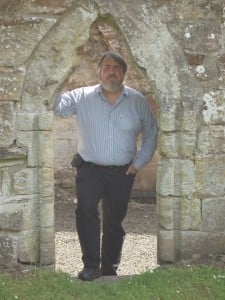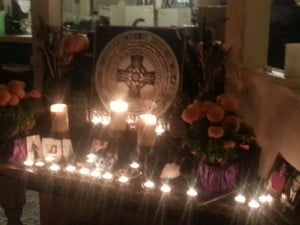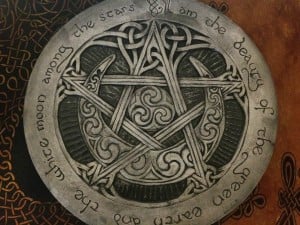The recent discussions here over what constitutes Pagan religion raised a number of issues with which Wiccan elder Don Frew has an unusual degree of experience. Few if any NeoPagans have been more active than Frew in our interactions with the wider religious world. Given that so much of our history is unavailable except orally, or in very specialized venues, I offered him an opportunity here to put some of these issues into a historical and I think very interesting context.
– Gus diZerega
ON SAVING PAGAN LIVES, INTER-PAGAN RELATIONS, ‘WICCAN PRIVILEGE’ AND THE IMPORTANCE OF INTERFAITH
 My perspective on the recent “Paganism” discussion is shaped by my experiences in five terms as a Public Information Officer for the Covenant of the Goddess in the 1980’s and ‘90’s and from 28 years of interfaith work on behalf of CoG. The Parliament of World’s Religions and the United Religions Initiative have been the central interfaith organizations where I served as a representative from CoG and at times as an officer within their own bodies. In so doing I was privileged to be an active participant in events of great importance to our community’s relations with the rest of the world. Important as they were, and sometimes mentioned as they are, what actually happened is little known today.
My perspective on the recent “Paganism” discussion is shaped by my experiences in five terms as a Public Information Officer for the Covenant of the Goddess in the 1980’s and ‘90’s and from 28 years of interfaith work on behalf of CoG. The Parliament of World’s Religions and the United Religions Initiative have been the central interfaith organizations where I served as a representative from CoG and at times as an officer within their own bodies. In so doing I was privileged to be an active participant in events of great importance to our community’s relations with the rest of the world. Important as they were, and sometimes mentioned as they are, what actually happened is little known today.
Saving Pagan Lives
The United Religions Initiative has grown to become the largest grass-roots interfaith organization in the world with over 600 local groups in over 85 countries. Witches have been involved since the writing of the URI Charter, and I am now serving my fourth term as a Trustee on the URI’s Global Council. Through the URI, I have seen the power that comes with the “indigenous, tribal, polytheistic, Nature-based, Earth-centered, and/or Pagan religions” being understood as a single group. One story illustrates this better than any other…
In 2004, I was part of the Parliament Assembly, a group of 450 representatives from various religious traditions as well as officials from organizations like the Red Cross and the World Bank, who met at Montserrat, Spain, for a few days in advance of the 2004 Parliament of the World’s Religions in Barcelona. We were charged with working on the four themes of that Parliament: access to clean water, the plight of refugees, relieving Third World debt, and ending religious violence. An ambitious charge.
We started out by meeting in small groups of eight or so. Each of us shared a personal story related to one or more of the themes. My group included Mussie Hailu, Vice Chair of the United Religions Initiative, and someone with whom I’ve worked in interfaith since the mid-1990’s. Mussie is a Coptic Christian from Addis Ababa, the capital of Ethiopia. He told us in Ethiopia there is an ethnic group called the Tabebe. The Tabebe possess the power of “tenkwe” – literally “far seeing”. One can be born into the Tabebe, or else discover that one has the power of tenkwe and go to the Tabebe for training. The Tabebe speak with nature spirits. People go to the Tabebe to have their fortunes told, for charms, for healing, etc. So far so good. They sounded a lot like Romanies, or Witches.
However, for many Ethiopians if a member of your family falls mysteriously ill, you figure out which of the Tabebe must have cursed the family member… and kill them to break the curse. The government turns a blind eye to this. In fact, Mussie elaborated, the Tabebe are considered so disreputable that they are not allowed to settle in cities, their children are not allowed to attend public school, and they are not allowed in the public hospitals.
When Mussie and his interfaith partner Sr. Laetitia Borg set out to create the first interfaith organization in Addis Ababa – a cooperation circle of the URI – he told her that they should reach out to the Tabebe. Like most people in the Abrahamic religions, Sr. Laetitia, didn’t see the Tabebe as a religious group and didn’t see a need to include them. At the next Global Summit of the URI, held in 1999 in Stanford, CA, Mussie came up to me and (without my knowing any of this back story with her) told me I needed to tell Sr. Laetitia all about Wicca. We had a long conversation over lunch, ended up friends, and did a blessing ceremony together at the end of the conference.
Mussie and Sr. Latitia went back to Adis Ababa and founded a URI group in Ethiopia. They included the Tabebe and for their CC logo they used a variation of the early URI logo that included a pentacle among its religious symbols. As they expected, leaders of religious groups in Ethiopia asked why they were including the Tabebe, and also asked why the URI was using this symbol. (The pentacle is widely associated with magic and until recently not with a religion.) Mussie and Sr. Laetitia explained that the pentacle is the symbol of Wicca and that Wicca is an international religion that speaks with nature spirits, looks into the future, does magic and healing… just like the Tabebe.
As light bulbs lit over the heads of religious leader after religious leader, the Tabebe were accepted into the interfaith community, and this acceptance led to the religious leaders pushing for changes in government attitudes. It worked. It is now against the law to kill a Tabebe and such crimes are prosecuted. They can live in cities. Their children can go to school. They have access to health care.
All of this directly follows from the courageous actions of a few people and the kind of relationships and conversations that interfaith work fosters. My fellow Pagans often ask me why we should do interfaith work. I have many standard answers, but after hearing this story from Mussie, I added that we should do this work to help preserve the lives of our fellow Earth religionists and create a future for their children.
The folks involved in the URI only knew about Witches and Wicca, but all of the groups that would until recently have been called “Neopagan” would have been included in this same larger grouping and would have benefited from the same increased understanding and acceptance. This brings me to another current issue.
NeoPagans and Indigenous Pagans
One increasingly less contentious issue is our legitimacy in the eyes of other religious communities, Pagan and non-Pagan alike. In this regard I’d like to comment on one particularly well-known event: the Declaration of War against Exploiters of Lakota Spirituality. I was at the 1993 Parliament of the World’s Religions in Chicago at which members of the Lakota read this statement. The Lakota hospitality suite was on the same floor of the Palmer House hotel as the joint Covenant of the Goddess / Circle / EarthSpirit hospitality suite. After the Declaration, we walked over and engaged the Lakota in conversation. We explained many aspects of the spiritual practices they felt had been “stolen” by Neopagans – addressing four directions, “sweat lodges”, etc. – had actually been a part of the spirituality of OUR ancestors as well. We shared their disapproval of appropriating material from other cultures.
Over a few days, friendships grew. They held a sunrise pipe ceremony outdoors, to which they invited the Neopagans. We held a full moon ceremony in a nearby park to which we invited the Lakota and other Native Americans, and they came and participated. Significantly, our ceremonies were the only two ceremonies held outdoors at that Parliament.
I’ll never forget opening the door to my bedroom – which was attached to our hospitality suite – only to find a Lakota Elder performing a pipe ceremony on my bed as part of a healing for one of the Neopagans. We made significant headway in improving relations between the Neopagan community and the Lakota.
At the 1998 Global Summit of the then-forming United Religions Initiative at Stanford University, CoG representative Deborah Ann Light and I noticed that the conversation seemed to be dominated by the Christian, Jewish, Muslim, and Buddhist representatives. Everyone else seemed relegated to the edge of the conversation as small or “alternative” religions. We organized a lunch to which we invited all the folks attending the conference who felt that a spiritual connection with the Earth was at the heart of their spiritual lives. As we gathered and signed in (for follow-up conversations) I noted Witches, Shinto practitioners, Taoists, Hindus, Native Americans from North, Central, and South America, practitioners of African and Pacific traditional religions, and others from many countries. Several environmental scientists who did not consider themselves “religious” joined us, saying they felt more at home with us than with any of the other groups.
We sat on the lawn, outside the cafeteria, in plain view of all the conference participants. As we, and they, looked around, it became apparent that we were about 15% of the conference participants. Suddenly, we went from being a bunch of disparate groups stuck on around the edges to being a “way” of being religious. We initially described that “way” to the larger assembly as “indigenous, tribal, polytheistic, Nature-based, Earth-centered, and/or Pagan religions”. But “Pagan” stuck, and people in the URI would – and still do – look back on “the Pagan lunch”, and many of the participants in the meeting found “Pagan” to be a simpler way of describing all of us that the long string of descriptive terms. (BTW, when I use “Pagan’ in the context of the “Pagan lunch” it is with the knowledge that one of the Principles of the URI encourages us to translate URI materials into our own languages. “Pagan” is what we tend to use in English, but local translations of something like “Earth Religion” is used in many other languages.)
The Issue of ‘Wiccan Privilege’
I have heard some Reconstructionists and “hard polytheists” complain they constantly have to explain that they are not Witches. Some complain about what they describe as “Wiccan privilege.” Let’s step back a bit.
Beginning in the 1950s, Witches led the way in educating the public about Paganism in general and Witches in particular. After decades of hard work by many people, we seem to be reaping both the benefits and problems of that education effort. For example, the United Religions Initiative started out using an image of the Earth surrounded by 15 religious symbols as its logo. (It has since moved on to something more abstract.) One of those symbols was a pentacle. A Wiccan symbol stood for all Neopagans as far as the URI was concerned. Why?
All of the Witches involved in interfaith (and CoG has been doing interfaith work since 1975) have ALWAYS explained that there are other Neopagans out there. We have usually specifically mentioned Druids and Heathens. However, this simply does not stick in people’s minds if the only Neopagans they ever meet are Witches. (At one meeting, I had to change my nametag after being identified as a “Druid”. The person in charge of the nametags had simply assumed that female Neopagans were “Witches” and male Neopagans were “Druids”.)
All of us who do any kind of public outreach or interfaith work are painfully aware of the need for qualifying language explaining that few, if any, beliefs or views are universal among Witches, even more so among Neopagans. The overriding difficulty is that a lot of information needs to be conveyed in what is usually a very short conversation (or “elevator speech”) or a few minutes at a microphone. You do the best you can, but people come away with an impression, more than any specific information. As long as the people doing the work are Witches, the impression is going to be of Witches, not of any other groups mentioned.
I am sorry about that. I genuinely am. However after decades of Witches sticking their necks out to explain that we weren’t Devil-worshippers or baby-murderers, the comparatively small amount of re-education and explanation that newer groups have to go through should be seen as a blessing rather than a curse. The plain fact is that the interfaith community – and by extension, the public that all of those ministers, priests, rabbis, and imams educate – will continue to equate Pagans and Wiccans until more non-Wiccan groups step up and do both interfaith work and public relations. Pagans of all types are more welcome than we had initially ever been in interfaith circles, but non-Witch Pagans and Heathens (and anyone else) still must explain who they are and how they are different from Witches.
Interfaith work itself is NOT about public relations! Maybe that’s why someone originally attends an interfaith gathering – to help folks understand their path better, as when someone requests a Pagan or Heathen to speak on a panel. But that’s just the start. Interfaith communities are people who understand from different perspectives that there is a spiritual component to the world and, in spite of our recognized differences, come together to work to improve the world for others. In my case I can meet, work with, and assist people around the world who live a vibrant indigenous “Pagan” spirituality that is often in danger of extinction. Where else can Aborigines, Shinto practitioners, American indigenous people, practitioners of African traditional spirituality & Afro-diasporics, Witches, Hindus, – yes, Heathens – and more, come together to share, learn from each other, provide tangible help to each other’s communities, and show the world that WE have something to offer THEM?
At one point, when the United Religions Initiative held its first Global Assembly in Rio de Janeiro in 2002, Rowan Fairgrove and I suddenly found ourselves on a stage with a camera and microphone in our faces. We were on CNN Latin America. “Why is interfaith important?” the guy with the mic asked. I said: “We all want to see change in the world – an end to violence, increased care and respect for the planet, equality between men and women, an end to hunger and poverty, and more. Well, the only true change comes about through changing people’s minds. Nothing has more influence over people’s minds than religion. Religions coming together to work cooperatively for the betterment of humanity and the Earth has the potential to be the most powerful force for positive change in the history of the world. As a person with a deep spiritual connection with the Earth – with a responsibility to help my family, my friends, my community – how can I not be involved?”
The Nature of Interfaith Work
Interfaith “work” is about making interfaith happen. It’s about pooling our energies and resources to act much more effectively than we can on our own. As the United Religions Initiative puts it, it’s about “promoting enduring, daily interfaith cooperation; ending religiously motivated violence; and creating cultures of peace, justice, and healing for the Earth and all living beings.” The capitalized E in “Earth” would not have been a part of that statement if not for the coordinated efforts of a Wiccan, a Hindu, a Taoist, and a Native American.
Interfaith work is about weekly meetings and committee work that usually have nothing to do with one’s own religious or spiritual path, except to the extent that everyone around the table knows that you are there because your path calls you to be there, and they are judging your path by that fact that it brought you there. The interfaith community has noticed that Witches show up, always help with setup and other work that is needed, and stay to help clean up. To be frank, those few interfaith folks who do understand that there ARE other forms of Paganism and revived / reconstructed Earth Religions, wonder where they are and why they don’t seem to be interested in participating.
I wrote this guest blog because of the hundreds of comments posted on the Wild Hunt in response to an article I wrote for the online journal, The Interfaith Observer, in November 2013. (BTW, I had no say in the title of the article.) As of January 24, 2014 there is only ONE comment to that article on the site. I don’t understand why a community would be so concerned about being “misrepresented” yet make no effort to correct the information in the venue where the article was posted. We welcome more voices representing more traditions, as long as they are polite, respectful, and “play well with others”.
How can WE not be involved? Mikhail Gorbachev said that “For all that divides us, we have but one planet.” Gorbachev wrote should speak even more profoundly to US. I invite those critical of ‘Wiccan privilege’ to do some serious investigation and reading on what is already going on in the world of national and global interfaith work. Check out The Interfaith Observer online, the North American Interfaith Network, the United Religions Initiative, and the Parliament of the World’s Religions, and if this work inspires you, as it does so many of us, get involved locally. Find your local interfaith group. We can help make connections. If there isn’t a group, start one. The URI makes it very easy to create a Cooperation Circle.
Witches have been actively involved in interfaith work – by which I mean working in meetings at least weekly – for over 28 years. The interfaith community is going to equate “Pagan” with “Witch” and “Wiccan”, no matter how much we try to explain that they are using both words incorrectly. As I said above, the ONLY way that is going to change is for more people of different Trads (or whatever) to get involved. I have been trying to encourage this for years. My URI Cooperation Circle – The Spirituality & the Earth CC – hosts an annual gathering of “People of the Earth” (described as “Neopagans, Immigrant Pagans, and Indigenous Traditions”) through the Interfaith Center at the Presidio in San Francisco. These have led to more and more Witches getting involved with interfaith work, but few of the other Neopagan groups. We would LOVE to have a wider diversity present, but we can’t force you to show up.
Clarifying Our Religion
I have been accused of “watering down” Wicca to make it acceptable to Christians for the sake of advancing us in the interfaith community. Nothing could be further from the truth. When circumstances have allowed time for in-depth discussions, I have had conversations with Bishops and Imams about entheogens, sacred sexuality at Beltane, being possessed by deities, working spells, and more. When interfaith work is based on developing personal relationships – as modern interfaith is – it’s possible to create a safe enough space to seriously discuss our differences. We can raise eyebrows without raising voices.
It’s true I explain Paganism in terms of polytheistic panentheistic monism. This is not an effort at “Christianization,” since most of the Christians with whom I speak completely disagree with all three concepts. I use this explanation because I firmly believe that it is accurate. I have discussed polytheistic panentheistic monism at great length with Shinto priests from Japan and the US, Hindu priests from India and the US, African shamans from several sub-Saharan countries, a Maori Elder Council spokesperson from New Zealand, a Taoist priest in the US, an Aymara shaman from Bolivia, a Maya priest from Guatemala, tribal elders from across Latin and North America, revered teachers of Chinese folk religion from Taiwan & Hong Kong, Afro-diasporic spiritual leaders from Brazil & Nigeria, and many more. Every single one of these teachers believed that the Gods and Goddesses (by whatever names or terms used in their traditions) were our most direct link to the spiritual unity that underlies everything, and manifests as and through the material world.
Based on this and my own study of ancient Paganisms as a Religious Studies major at UC Berkeley, it is clear to me that polytheistic panentheistic monism is far and away the most common (nearly universal) understanding of the cosmos found in “Pagan” (in the broadest sense) religions. (Until this recent discussion of “hard polytheism”, the only exception I had encountered was a tribe in the Kalahari Desert in South Africa that focuses exclusively on dead ancestors who sometimes impart stones, or plants, or other objects with magical properties that are of use to the tribe, but otherwise have no concept of either Gods or of a sacred Earth.) As long as polytheistic panentheistic monism seems to represent at least 90% of the world’s Pagans, throughout human history, I will continue to use it to explain Paganism, while always acknowledging that there will always be groups with other views.
I like to say that as religions seeing the Divine manifest in, and as, the material world, we have to expect that the Divine is both as unified as, and at least as diverse as, the natural world. There is one Earth, but innumerable climates and geographies, flora and fauna. It should be no surprise that our spiritualities reflect this.
I’d also like to point out that every religious community has language that it uses to describe itself to those not of the community, and language that it uses internally. For example, I was flabbergasted to discover that many Lutherans do not consider themselves to be Protestants! As a Religious Studies scholar, I always believed that Lutherans defined Protestantism. However, while Lutherans are Protestants in the taxonomic sense, among themselves they eschew the term, believing that it was co-opted by Knox and Calvin. In the same way, I firmly believe that “Pagan” and the sub-category “Neopagan” are the most useful terms for talking about ALL of us – Witches, Heathens, Reconstructionists, “hard polytheists”, etc. – to the outside world, while understanding that within our community this is a more complex issue under discussion and in flux.
I find it ironic that many of the Reconstructionists and “hard polytheists” in this discussion keep referring to “Wiccans”. As a Gardnerian, I wince every time “Wicca” is used synonymously with modern Witchcraft as a whole, including popular or eclectic Witchcraft, but I accept that this has become the common usage and don’t waste precious time trying to explain the differences between traditions to outsiders, unless I have time to spend. You have to pick your opportunities for education as much as you pick your battles. “Wiccan” has become part of our external language, while internally, I would never refer to a Strega as a “Wiccan”.
I have heard complaints that Witches are speaking for other groups when they have no right to be doing so. I never claim to speak for anyone other than CoG. But when I am in meeting after meeting and the only people sitting around the table are Christians, Muslims, Jews, some Buddhists, and me, what am I supposed to do when a decision is about to be made that will adversely affect Shintoists, or indigenous people, or Hindus, or Heathens? Stay quiet? Or do my best to point out the problem and explain the concerns? Time after time, I have chosen the latter. I apologize if that has been presumptive on my part. However, I KNOW that (based on our long history of participation) other people have done the same for Witches in other meetings all over the world, and I am very glad they have.
I am very proud of what we Wiccans involved in both public education and interfaith work have accomplished. I think we have made the world a better, safer place for ALL modern Pagans / Earth Religionists. I know for a fact that we have saved uncounted lives around the world. And while I am open to positive, constructive suggestions and criticism (when they are directed to me and not voiced in a forum I may not even know exists), I am going to continue doing this work for the rest of my life.
Thanks & Blessed Be,
Don Frew















